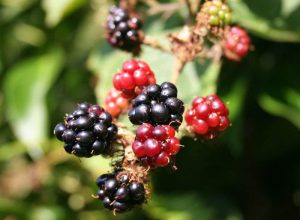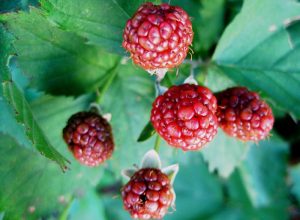Hybrid Raspberry – Rovo – Ribes Nigridolaria


Both were selected last century, The Boysenberry in the 20s in California, and the Tayberry in the 70s, in Scotland, These hybrids were obtained by crossing the Raspberry (Rubus idealus) with the Rova (Rubus Ulmifolius)
Both with the same characteristics as the plant from which they originated.: growing in all the temperate zones of the Continent, they are pollonferi shrubs covered in thorns, which can sometimes be annoying, more vigorous the Boysenberry, they are both sarmentous, therefore it is necessary to support the structure; they have deciduous leaves, even if in specific atmospheric and climatic conditions the leaves can resist on the branches until the following vegetation.
TERRAIN
They love soft terrain, rich in organic substances, humid but without stagnant water, they require a position which is preferably sunny but very important it should have a notable circulation of air to avoid dangerous rot which can strike the fruit in its maturing stages. They can suffer from strong and prolonged periods of gel.
Remember that PRANDINI’S GARDEN NURSERY CENTRE is always available to collaborate and give advice on the density of planting, form of rearing, crop choice and plant health for new productive implants even of modest dimensions.
FLORA AND FRUITS
The fruit is relatively big, self pollinating and appears on the vegetation as a sort of pollen from the previous year, white with showy pistils, it flowers in early Spring, , in periods when you preserve from late ice.
Black Fruit like the rovo, for the Boysenberry, and red like the Raspberry, for the Tayberry, you can differentiate the plants from the originals by the size which is much more superior and by the flavour which is more aromatic and with a less accentuated sour element. The fruit picking period is shorter with respect to the mother plant, lasting only one month in Summer according to the variety, but is more practical given the size of the fruit.
Varieties of Raspberry/Rovo hybrids cultivated by PRANDINI’S GARDEN NURSERY CENTRE
- TAYBERRY
- BOYSENBERRY
USE AND HEALTH GIVING PROPERTIES
Ideally eaten freshly picked, it lends well to fruit salads, jams,juices etc. it is much used in pastry baking where, apart from the taste, it also has a notable visionary aspect. The fruit lends to being frozen.
As with all summer fruit, it is rich in substances which are useful to the organism:
Just a few fruit are sufficient to reach the RDA. Remember that RDA is an acronym for Recommended Daily Allowance, which indicates the number of vitamins and mineral salts the person should consume to satisfy the minimum daily requirements.
About 10 fruit surpasses the RDA calcium, magnesium, phosphorus, potassium, manganese, apart from the ever present high quantities of vitamin C. Antociani and proancianidine are also present, useful antioxidents against the formation of free radical.
POTTING PRUNING AND CULTIVATION
The raspberry and rovo hybrids are very simple plants with few demands.
Winter potting consists of the elimination of the pollen which has fruited and to thin out the year’s growth, shortening the remains if too invasive.
If the soil is that ideal, it is not necessary to fertilize regularly, every two or three years spread some well decomposed organic substance, water only in the case of extreme dryness, especially as the fruit is enlarging.
Pay Attention: never water with shower watering because the water that remains on the fruit could in a short time form mould.
And it is actually this grey mould (botrytis) the main fungus which can easily strike the fruit especially , on humid days, while a parasite attack is very rare, it is the same for the raspberry, the rovo, the Cicadellide (see Rovo) and the bollworm of the raspberry.
Also in this case, given the presence of flowers or fruit, insecticide treatments are somewhat difficult.
